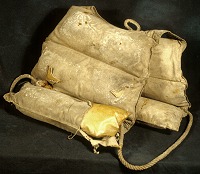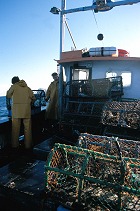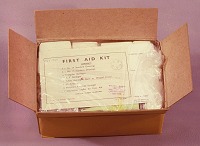Back to start | Fire and Flood
Health and Safety

All fishing boats are fitted with safety gear. This is to try to minimise the risks if there is a problem while at sea. For example, self-inflating life rafts are carried and these should be checked annually by a professional. It is also recommended that fishermen wear lifejackets. However many fishermen say the jackets are too bulky and make it difficult to work on board. Manufacturers are constantly improving the designs so that even if a man is washed overboard, there is some hope of recovering him. The fishing boats all have radios and they can call on fellow fishermen, the RNLI or HM Coastguard to assist in an emergency. Boats also carry distress beacons and flares. Skippers are also encouraged to practise safety drills. This helps to ensure that every crewmember is aware of what to do if, for example, a man is washed overboard. To find out more about safety see the Safety at Sea resource pack.

One of the most dangerous types of fishing is creel fishing. This is where fishermen fish for crabs and lobsters using baskets called creels. Creel-fishermen operate only a few miles from shore, and most work alone. If they do get into difficulties, there is no one there to help them. They must navigate, and sail the vessel single-handedly. They also have to deal with their creels and lines. If they are lucky, other boats will be working nearby. But even if these boats have been alerted, by the time they reach the vessel it may be too late to prevent an accident becoming a tragedy. It is even more important that fishermen operating alone take safety precautions. They can wear a lifejacket, or even a safety harness and an individual locator beacon.

Even with all this equipment and protective clothing, the men are not completely safe. There are so many hazards when handling wet and salty nets for hours. Most of this work is in the open or, at best, under the partial cover of a shelter deck. On deep-sea trawlers, for example, the fish is gutted at sea. The men can be afflicted with sea boils, cracks and poisoned hands. These are caused by cuts and chafing from fish, ropes etc. and the intense cold. It has been said their bent, mutilated hands mark trawlermen. There were no medical facilities for fishermen at sea until the first Mission Ships were provided by charity in 1882. They carried doctors, tobacco sales and spiritual comforts such as hymn singing and sermons to the fleets.
Back to start | Fire and Flood